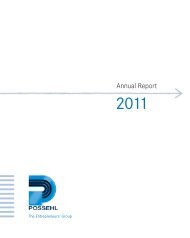Group - L. Possehl & Co. mbH
Group - L. Possehl & Co. mbH
Group - L. Possehl & Co. mbH
Create successful ePaper yourself
Turn your PDF publications into a flip-book with our unique Google optimized e-Paper software.
aC<strong>Co</strong>UNtiNG PriNCiPLES<br />
intangible assets acquired for valuable consideration are carried<br />
at cost less scheduled amortization on a straight-line basis and any<br />
unscheduled amortization as necessary. Scheduled amortization<br />
normally takes place over the contractual or expected useful life of the<br />
individual assets. Licenses and similar rights are normally amortized<br />
over a useful life of one to five years.<br />
Goodwill resulting from initial consolidation is recognized directly<br />
in equity in the <strong>Group</strong>’s retained earnings. All other goodwill is<br />
amortized over the expected amortization period of up to 15 years.<br />
Property, plant, and equipment are carried at cost, less<br />
scheduled depreciation for use and any unscheduled depreciation as<br />
necessary. If the basis for unscheduled depreciation no longer exists,<br />
the assets are written back. <strong>Co</strong>sts of property, plant, and equipment<br />
produced internally include an appropriate portion of overhead costs,<br />
including depreciation of production equipment, as well as the direct<br />
costs. <strong>Co</strong>sts of debt financing are not included in production costs.<br />
Assets of minor value are fully depreciated in the year purchased and<br />
shown in the asset schedule under disposals.<br />
Public subsidies for the purchase or manufacture of assets are<br />
deducted from the cost of those assets.<br />
Property, plant, and equipment are normally depreciated over their<br />
expected useful life on a straight-line basis. In the Electronics division,<br />
tools are depreciated based on a combination of useful life and actual<br />
use over a maximum period of four years.<br />
Scheduled depreciation is based on the following assumptions of<br />
useful life:<br />
40<br />
years<br />
Buildings 20 – 50<br />
Technical plant and machinery 5 – 10<br />
Tools 1 – 4<br />
Operating and office equipment 3 – 10<br />
Carrying amounts for associated companies reported under financial<br />
assets are adjusted for the pro rata share of profit and loss, taking<br />
account of dividend payments. These adjustments are disclosed in the<br />
asset schedule as additions or disposals. Equity investments in subsidiaries<br />
that are not fully consolidated and other equity investments<br />
are recognized at cost less any impairment losses. Loans bearing no or<br />
a low rate of interest are recognized at present value. Interest bearing<br />
loans are always recognized at nominal value. Securities held as fixed<br />
assets are recognized at cost.<br />
inventories are carried at the lower of cost or quoted/market<br />
price or fair value on the balance sheet date. Production-related overhead<br />
costs and depreciation of production-related property, plant, and<br />
machinery are included in addition to direct costs of production.<br />
Financing costs are not included. Inventories are measured using the<br />
average cost method, except for precious metals, which are measured<br />
using the Last-in-First-out method, in line with common practice in<br />
the industry. Inventories are written down if their realizable value is<br />
diminished due to longer storage periods. The principle of “lower of<br />
cost or market” is respected.<br />
advanced payments received for inventories are deducted<br />
directly from the carrying amounts.<br />
receivables and other assets are normally recognized at the<br />
lower of nominal value or fair value as per the balance sheet date. Any<br />
risks are accounted for by individual write downs of 1 % of the carrying<br />
amount of receivables not written down individually.<br />
tax receivables and tax liabilities are normally recognized at the<br />
amount expected to be received or paid to the tax authorities.<br />
For the first time, pension provisions are measured according<br />
to the projected benefit credit method in line with IAS 19 taking into<br />
account future compensation and pension adjustments. The calculation<br />
is based on the following parameters:<br />
Actuarial interest rate 5.3 %<br />
Salary growth 3.0 %<br />
Pension growth 1.5 %




